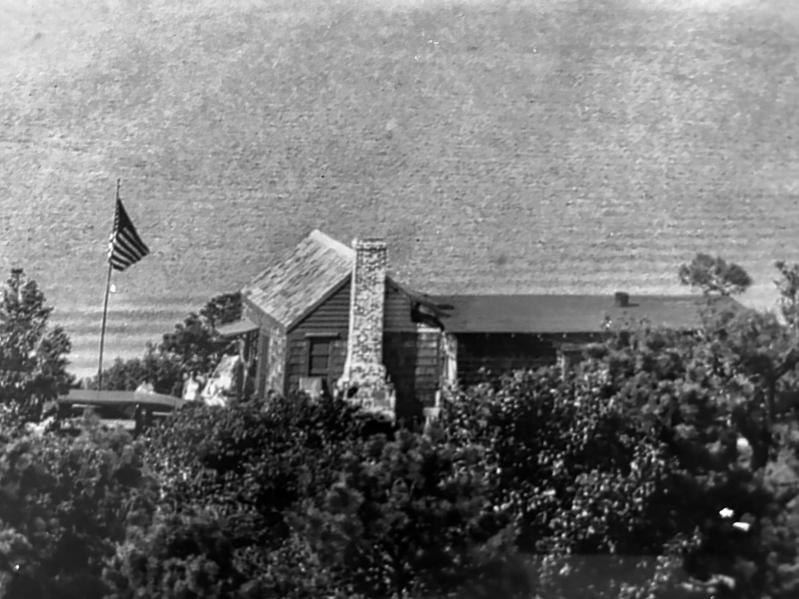In the summer of 1945, my father, grandfather, and Uncle Joe — an astrophysicist, a minister, and a theologian, respectively — built a three-room shack on the shores of Peconic Bay. With great bravado these three reasoned that their collective intelligence transferred to house building.
They constructed the living room using old church doors salvaged from a Cincinnati church. My grandfather laid the brick fireplace claiming expertise because his grandfather had been a mason. Together they clad the exterior with cedar shingles; the interior rooms were never faced with plasterboard, thus exposing walls dotted with the sharp tips of the nails from the outside shingles. This makeshift edifice became our family’s summer retreat. We called it “Camp.”
Even though we often needed to put out pots to catch the rainwater in the bedrooms, even though we lost our sailboat in a nor’easter, and even though my sister fell out the window onto her head and received six stitches, we all thought that there was no better place in the world.
For most of my childhood there was no four-lane highway running through Shinnecock Hills. The only noises came from the foghorn at the end of the Shinnecock Canal jetty, the lapping waves, and the crunch of the broken clamshells on the driveway as a car drove up to the house. The nightly high-pitched chirp, chirp, chirp of crickets was our August lullaby. Friends addressed our mail to “General Delivery, Shinnecock Hills, Long Island, N.Y.,” and we picked it up from the postmaster, Mrs. Terwilliger, who lived in the original Shinnecock Hills train station that served as a post office.
My sisters and brothers and I learned to swim wearing orange life preservers, graduating to an inner tube and then simply let go to stay afloat. Our beach toys were perfect and imperfect scallop, clam, oyster, mussel, whelk, and conch shells. We dug tunnels in the sand, connecting our hands halfway through, created elaborate drip sand castles, and believed we could dig to China.
On beach walks we searched for quartz arrowheads and ancient “paint pots.” We knew Shinnecock Hills was once the home of the Shinnecock Nation and treasured these finds. What we were never told were the ways the 17th-century English settlers, our ancestors, extracted the land from the native peoples who had lived for 13,000 years on the sandy hills between Peconic and Shinnecock Bays.
While our days unfolded in imaginative play, they were also shaped by our elders. Grandpa taught us to cook clam chowder using the quahogs we dug up at low tide with our toes. We picked ripened beach plums from the same bushes William Merritt Chase painted in his luminous Shinnecock Hills landscapes and proudly presented them to our grandmother, who made the beach plum jelly we slathered on our morning toast throughout the winter.
Mother believed that saltwater cured everything, and if we were sick, or had cuts, bug bites, or bruises, into the water we went. Daddy introduced us to the thrill of watching the night sky. He’d point out the North Star, the Big and Little Dippers, and we stayed up late to watch for shooting stars during the August Perseid meteor showers. For a few short minutes we once witnessed the green and purple swirling streaks of the northern lights. These stargazing evenings were accompanied by the sweet and spicy smell of tobacco smoke from Daddy’s pipe.
Rainy days, we slipped into bright yellow rain slickers as if we were seamen and drove to the Montauk Lighthouse.
The end of summer brought about a two-day routine of “closing up the house.” Towels, linens, pillows went into the cedar closet, bathing suits and shorts into trunks. Daddy drained the water pipes and turned off the gas and electricity.
Then came the dreaded day of departure. As we waited in the tightly packed car, Mother pulled the front door closed for the last time, and with that — summer was over. As she collapsed, weeping, into the passenger seat, Daddy extended his arm to comfort her. In silence, we listened to the crunch, crunch, crunch of the clamshells as we slowly drove out the long driveway.
As we glanced backward into happiness, tranquillity, and security, Camp, our home away from home, disappeared. Gone, the cold plunges into the bay. Gone, the rainy-day Monopoly games. Gone, the nights under the stars. Gone, the closeness we felt as a family. The ride home was when I first experienced what my grandmother called “the pain of a heavy heart.”
Years later, Mother would tell me, “Leaving Camp I was always consumed by the fears of what might lay ahead, wondering if I had the strength to keep our family whole.” Indeed, she kept us whole, and now here I am, all these years later, taking on the legacy of her end-of-summer fears — and her tears.
Cynthia Van Allen Schaffner is a decorative-arts historian who lives in East Hampton.

